engine coolant CHEVROLET ASTRO PASSENGER 1994 1.G User Guide
[x] Cancel search | Manufacturer: CHEVROLET, Model Year: 1994, Model line: ASTRO PASSENGER, Model: CHEVROLET ASTRO PASSENGER 1994 1.GPages: 340, PDF Size: 16.86 MB
Page 198 of 340
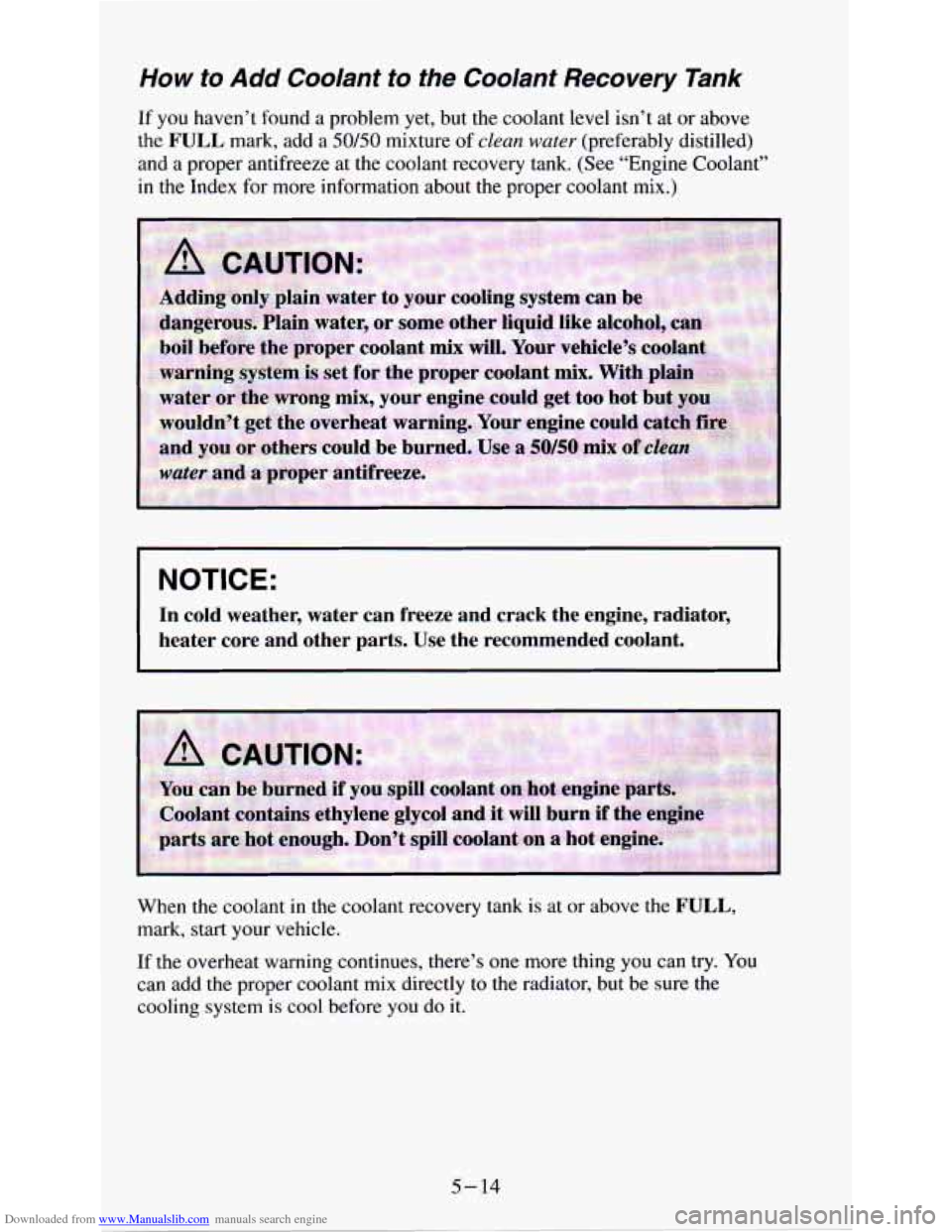
Downloaded from www.Manualslib.com manuals search engine How to Add Coolant to the Coolant Recovery Tank
If you haven’t found a problem yet, but the coolant level \
isn’t at or above
the
FULL mark, add a 50/50 mixture of clean water (preferably distilled)
and
a proper antifreeze at the coolant recovery tank. (See “Engine Coolant”
in the Index for more information about the proper coolant mix.)
..
..
I NOTICE:
In cold weather, water can freeze and crack the engine, radiator,
heater core and other parts. Use the recommended coolant.
When the coolant in the coolant recovery tank is at or above the FULL,
mark, start your vehicle.
If the overheat warning continues, there’s one more thing
you can try. You
can add
the proper coolant mix directly to the radiator, but be sure the
cooling system
is cool before you do it.
Page 199 of 340
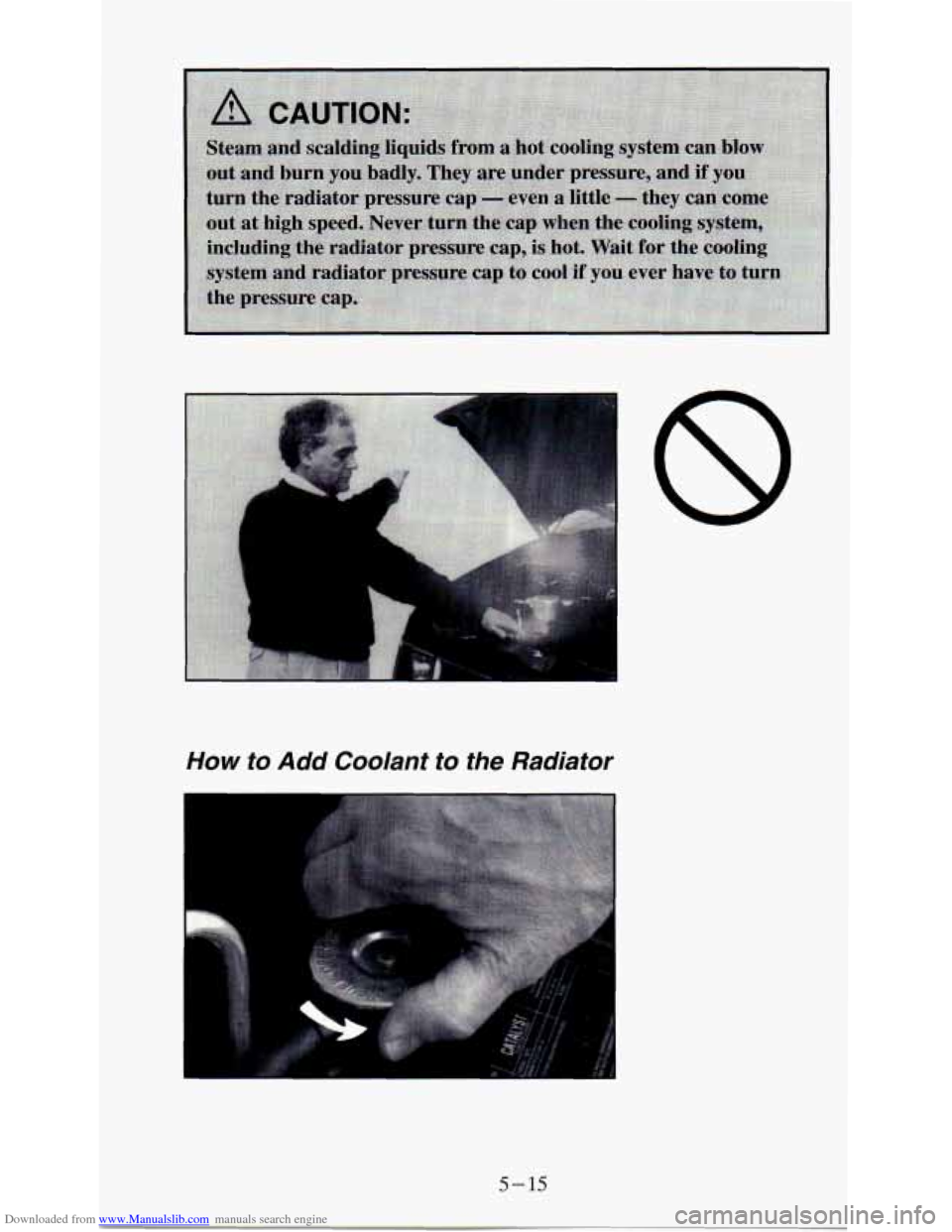
Downloaded from www.Manualslib.com manuals search engine How to Add Coolant to the Radiator
5-15
Page 201 of 340

Downloaded from www.Manualslib.com manuals search engine I
4. Then fill the
coolant recovery tank to
FULL.
5. Put the cap back
on the coolant
recovery tank,
but leave the
radiator pressure
cap off.
6. Start the engine
and let it run until
you can feel the
upper radiator
hose getting hot.
Watch out for
the
engine fan.
7. By this time the coolant level inside the radiator filler neck may be
lower.
If the level is lower, add more of the proper mix through the
filler neck
until the level reaches the base of the filler neck.
5-17
Page 202 of 340
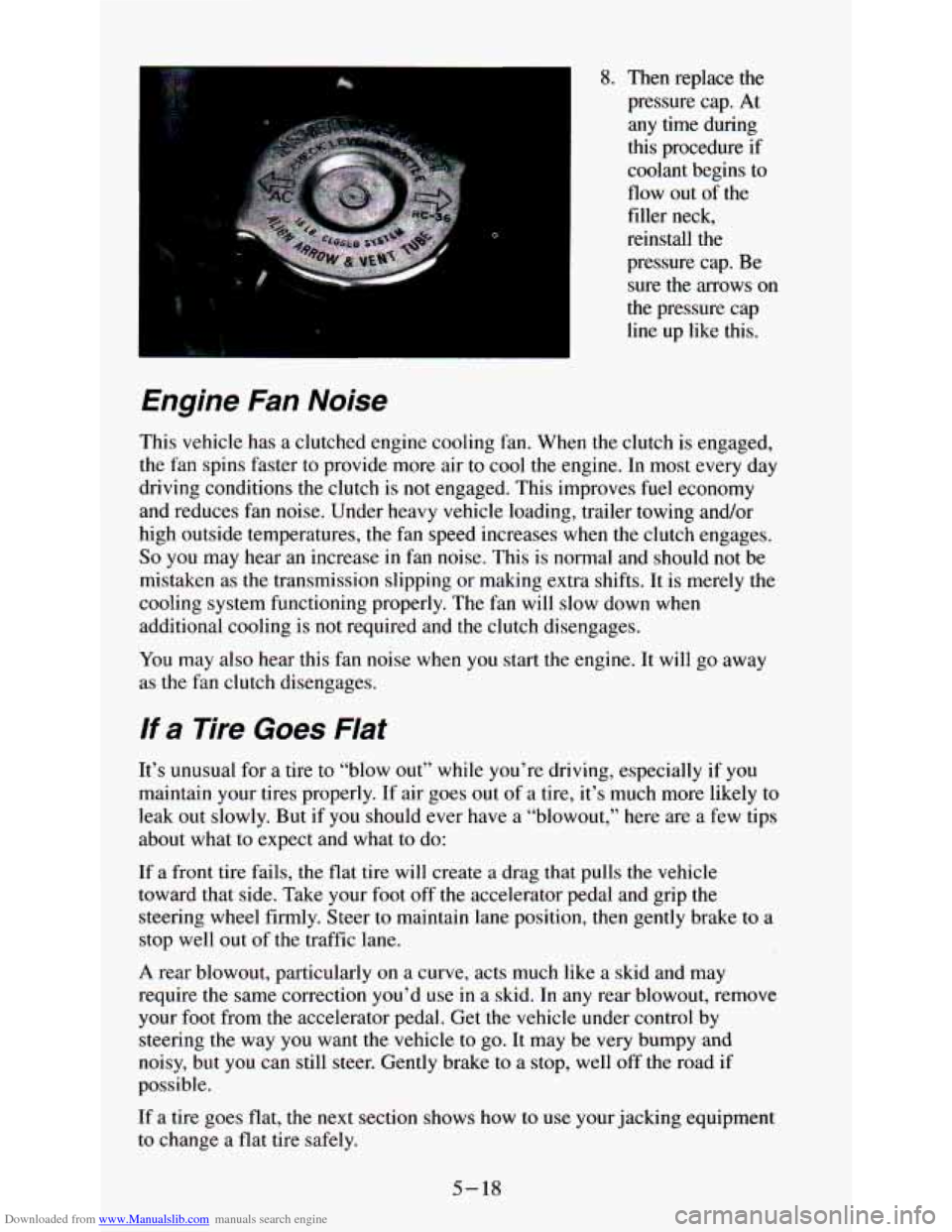
Downloaded from www.Manualslib.com manuals search engine 8. Then replace the
pressure cap. At
any time during
this procedure
if
coolant begins to
flow out of the
filler neck,
reinstall the
pressure cap. Be
sure the arrows on
the pressure cap
line up like this.
Engine Fan Noise
This vehicle has a clutched engine cooling fan. When the clutch is engaged,
the fan spins faster to provide more
air to cool the engine. In most every day
driving conditions the clutch is not engaged. This improves fuel economy
and reduces fan noise. Under heavy vehicle loading, trailer towing and/or
high outside temperatures, the fan speed increases when the clutch engages.
So you may hear an increase in fan noise. This is normal and should not be
mistaken as the transmission slipping or making extra shifts. It is merely the
cooling system functioning properly. The fan will slow down when
additional cooling is not required and the clutch disengages.
You may also hear this fan noise when you start the engine. It will go away
as the
fan clutch disengages.
If a Tire Goes Flat
It’s unusual for a tire to “blow out” while you’re driving, especially if you
maintain your tires properly.
If air goes out of a tire, it’s much more likely to
leak out slowly. But if you should ever have a “blowout,” here are a
few tips
about what to expect and what to do:
If a front tire fails, the flat tire will create a drag that pulls the vehicle
toward that side. Take your foot off the accelerator pedal and grip the
steering wheel firmly. Steer to maintain lane position, then gently brake to a
stop well out of the traffic lane.
A rear blowout, particularly on a curve, acts much like a skid and may
require the same correction you’d use
in a skid. In any rear blowout, remove
your foot from the accelerator pedal. Get the vehicle under control
by
steering the way you want the vehicle to go. It may be very bumpy and
noisy, but you can still steer. Gently brake to a stop, well off the road if
possible.
If a tire goes flat,
the next section shows how to use your jacking equipment
to change a flat tire safely.
5-18
Page 219 of 340

Downloaded from www.Manualslib.com manuals search engine Service & Appearance Care
...
Section
Here you will find information about the care of your vehicle . This part
begins with service and fuel information. and then it shows how to check
important fluid and lubricant levels
. There is also technical information
about your vehicle. and a section devoted to its appearance care
.
Service ................................................... 6-2
Fuel
..................................................... 6-3
Checking Things Under the Hood
.............................. 6-7
Hood Release
........................................... 6-7
Engineoil
.............................................. 6-9
Enginecover
.......................................... 6-15
Air Cleaner
............................................ 6-19
Automatic Transmission Fluid ............................. 6-20
RearAxle
............................................. 6-24
All-WheelDrive
........................................ 6-24
Transfercase
.......................................... 6-24
FrontAxle
............................................. 6-25
Engine Coolant
....................................... 6-26
Windshield Washer Fluid
................................. 6-31
Brake Master Cylinder
................................... 6-32
Replacing Brake System Parts
.................... ........ 6-35
Battery
.................................................. 6-35
Vehiclestorage
......................................... 6-35
FluidLeakCheck
.......................................... 6-36
Bulb Replacement
......................................... 6-36
Other Maintenance Items
.................................... 6-41
Tires
.................................................... 6-47
Appearancecare
.......................................... 6-54
Vehicle Identification Number
................................ 6-63
Service Parts Identification Label
..................... .... 6-65
Capacities and Specification Charts
................ . . 6-68
Fuses and Circuit Breakers ........... 6-72
Power Steering Fluid .................................. 6-30
Loading Your Vehicle
.... .............................. 6-44
6-1
Page 232 of 340

Downloaded from www.Manualslib.com manuals search engine Engine Oil Additives
Don’t add anything to your oil. Your GM dealer is ready to advise if you
think something should be added.
When to Change Engine Oil
See if any one of these is true for you:
Most trips are less than 4 miles (6 km).
It’s below freezing outside and most trips are less than 10 miles
(16
km).
The engine is at low speed most of the time (as in door-to-door
You tow a trailer often.
delivery,
or in stop-and-go traffic).
0 Most trips are through dusty places.
If any one of these is true for your vehicle, then
you need to change your oil
andfilter every 3,000 miles (5 000 km) or 3 months - whichever comes
first
.
If none of them is true, change the oil every 7,500 miles (12 500 km) or
12 months
- whichever comes first. Change the filter at the first oil change
and at every other oil change after that.
Engine Coolanf Heater (Engine Block Heater)
An engine coolant heater can be a big help if you have to park outside in
very cold weather,
0°F (-18°C) or colder. If your vehicle has this option,
see “Engine Coolant Heater” in the Index.
What to Do with Used Oil
Did you know that used engine oil contains certain elements that may be
unhealthy for your
skin and could even cause cancer? Don’t let used oil stay
on your skin for very long. Clean your skin and nails with soap and water,
or a good hand cleaner. Wash or properly throw away clothing or rags
containing used engine oil. (See the manufacturer’s warnings about the use
and disposal of oil products.)
Used oil can be a real threat to the environment. If you change your own oil,
be sure to drain all free-flowing oil from the filter before disposal. Don’t
ever dispose of oil by putting it
in the trash, pouring it on the ground, into
sewers, or into streams or bodies of water. Instead, recycle it by taking it to
a place that collects used oil. If you have a problem properly disposing of
your used oil, ask your dealer, a service station or a local recycling center
for help.
6-14
Page 244 of 340

Downloaded from www.Manualslib.com manuals search engine What to Use
Refer to the Maintenance Schedule to determine what kind of lubricant to
use. See “Recommended Fluids
and Lubricants” in the Index.
Engine Coolant
The following explains your cooling system and how to add coolant when it
is low. If
you have a problem with engine overheating, see “Engine
Overheating” in the Index.
The proper coolant for your vehicle will:
0 Give freezing protection down to -20°F (-29”C), or -34°F (-37°C) in
0 Give boiling protection up to 258°F (125 “C).
0 Protect against rust and corrosion.
0 Help keep the proper engine temperature.
0 Let the warning gages work as they should.
Canada
and for vehicles with the cold climate option.
What to Use
Use a mixture of one-half clean water (preferably distilled) and one-half
antifreeze
that meets “GM Specification 6038-M,” which won’t damage
aluminum parts. You can also use a recycled coolant conforming to
“GM
Specification 603%”’ with a complete coolant flush and refill. If you use
this mixture,
you don’t need to add anything else.
6-26
Page 245 of 340
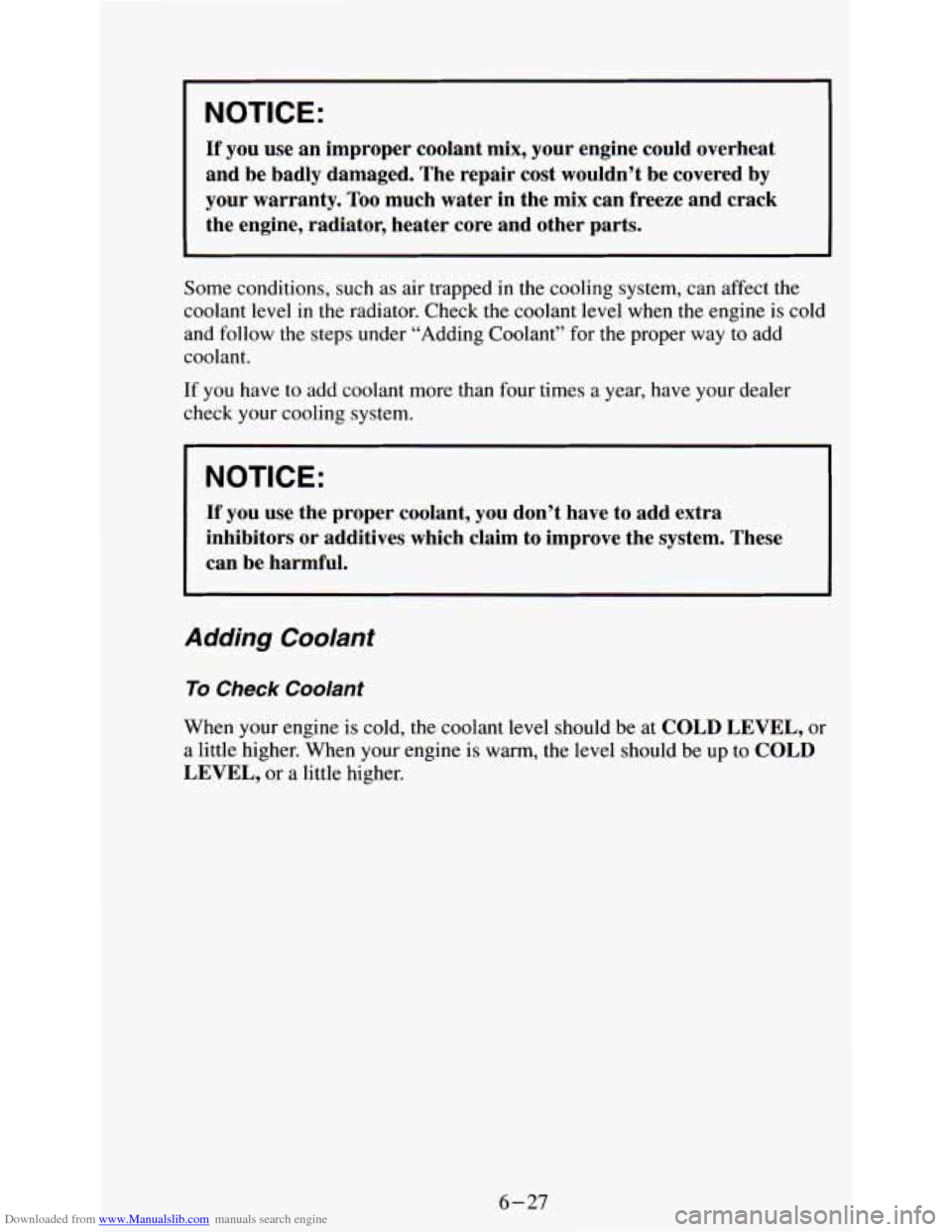
Downloaded from www.Manualslib.com manuals search engine I NOTICE:
If you use an improper coolant mix, your engine could overheat
and be badly damaged. The repair cost wouldn’t be covered by
your warranty. Too much water in the mix can freeze and crack
the engine, radiator, heater core and other parts.
Some conditions, such as air trapped in the cooling system, can affect the
coolant level
in the radiator. Check the coolant level when the engine is cold
and follow the steps under “Adding Coolant” for the proper way to add
coolant.
If you have to add coolant more than four times a year, have your dealer
check your cooling system.
I NOTICE:
If you use the proper coolant, you don’t have to add extra
inhibitors or additives which claim to improve the system. These
can be harmful.
Adding Coolant
To Check Coolant
When your engine is cold, the coolant level should be at COLD LEVEL, or
a little higher. When your engine is warm, the level should be up
to COLD
LEVEL, or a little higher.
6-27
Page 246 of 340
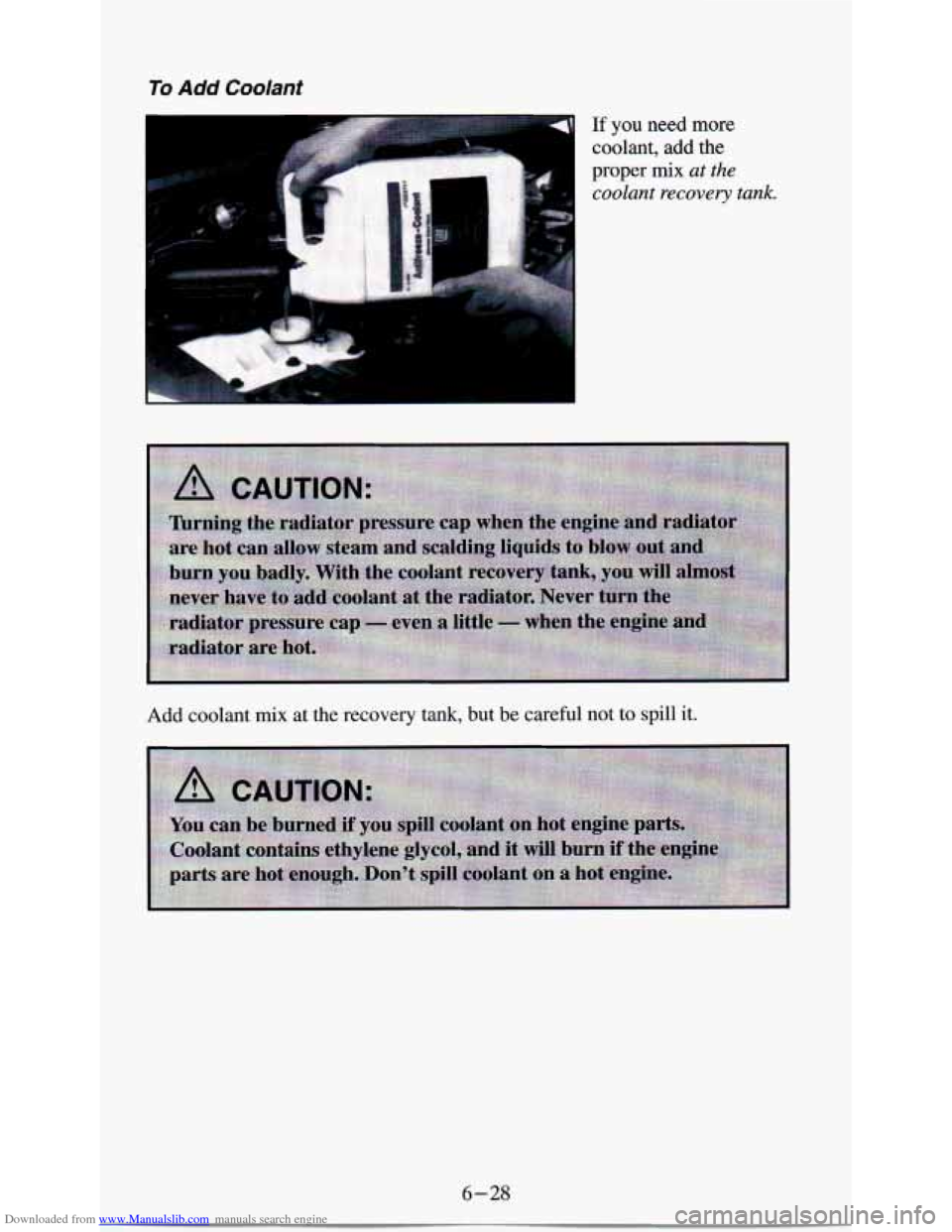
Downloaded from www.Manualslib.com manuals search engine To Add Coolant
-3 If you need more
coolant, add the
proper
mix at the
coolant recovery tank.
Add coolant mix at the recovery tank, but be careful not to spill it.
6-28
Page 247 of 340
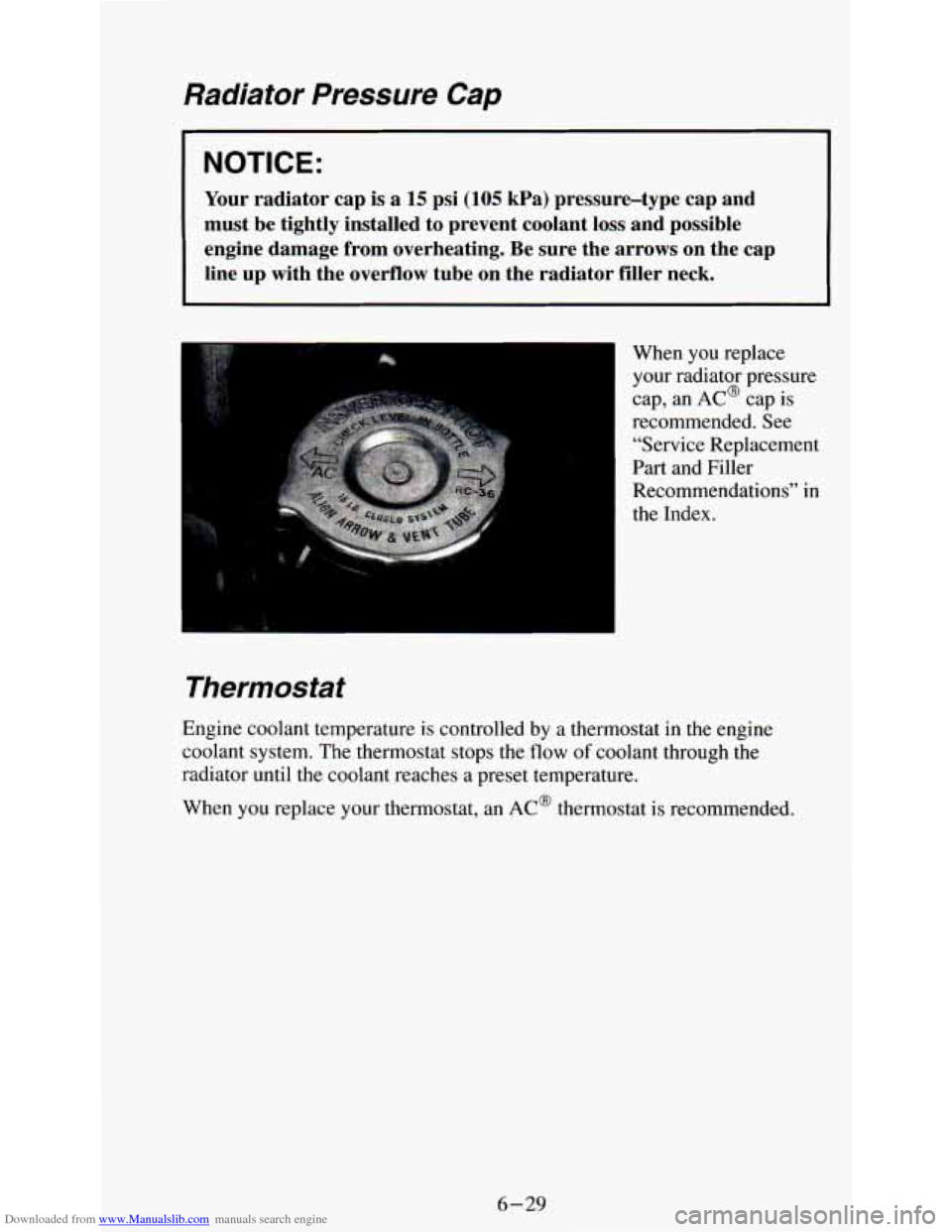
Downloaded from www.Manualslib.com manuals search engine Radiator Pressure Cap
NOTICE:
Your radiator cap is a 15 psi (105 kPa) pressure-type cap and
must be tightly installed to prevent coolant
loss and possible
engine damage from overheating. Be sure the arrows on the cap \
line up with the overflow tube on the radiator filler neck.
When you replace
your radiator pressure
cap, an
AC@ cap is
recommended. See
“Service Replacement
Part and Filler
Recommendations”
in
the Index.
Thermostat
Engine coolant temperature is controlled by a thermostat in the engine
coolant system. The thermostat stops
the flow of coolant through the
radiator until the coolant reaches a preset temperature.
When you replace your thermostat, an
AC’ thermostat is recommended.
6-29